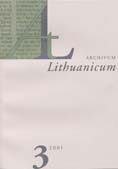Spaustuvininku itaka rašybai ir jos standartams
The influence of printers on textual orthography and orthographic standards
Author(s): Giedrius Subačius Subject(s): Theoretical Linguistics, Philology
Published by: Lietuvių Kalbos Institutas
Keywords: Textual ortography; Printers and their influence; orthographic standards;
Summary/Abstract: Noel E. Osselton (1963, 1984, 1985) and Ingrid Tieken-Boon van Ostade (1988) have described the double standard in eighteenth century English orthography consisting of private and public, or manuscript and printers. In contemporary terms, this would be polite and pedantic, or gentlemen's and scholarly. It is important to emphasize that both standards were prestigious in certain social strata, and that there is an evident time lag in the development between gentlemen's (private, polite) and scholarly (public, printers) spelling conventions. Printers used to standardize orthography according to their own convenience. For instance, Osselton has written about orthographic variation in -or or -our (e.g. author or authour) in Samuel Johnson's texts: "When it came to opting for one form or the other for insertion in the Dictionary he often chose a form in conflict with his own preferred practice [...], but his choice, when he did this, was determined by the printers usage of forty years before (Osselton 1963, 271).
Journal: Archivum Lithuanicum
- Issue Year: 2001
- Issue No: 03
- Page Range: 129-152
- Page Count: 24
- Language: Lithuanian

